The Administration

Visit the EOP to learn more about the Executive Office of the President.
The Administration
The President of the United States is very powerful and is consequently responsible for decisions every day that affect America's future. So, how can one person handle all the responsibilities and pressures required by one position? In this lesson you will learn about the administration, the people who work within the Executive Branch to help the President plan and carry out laws. Every President has an administration made up of thousands of people who work in the White House, the Cabinet, and the Executive Office of the President to help them carry out the enormous job of President of the United States.
Executive Office of the President
The Executive Office of the President (EOP) was created by President Franklin Roosevelt in 1939 to provide support to the President needed to make the decisions to govern effectively. The EOP is the President's right arm and is made up of several agencies responsible for a wide range of tasks. Offices of the EOP include: the White House, National Security Council, Office of Management and Budget, and Council of Economic Advisors, and several more.
The White House Office
The President's closest advisors and personal staff make up the White House Office, which is the core of the EOP. Members of the President's personal staff work in the White House Office and are appointed by the President. They are not subject to Senate confirmation.
The Chief of Staff is the most powerful member of the White House Office. In addition to overseeing the EOP, the chief of staff manages the White House Office. The job varies in different administrations and ranges from primary adviser to the President to managing daily operations of White House. The chief of staff often decides who will meet with the President.
White House Staff
There are several other official staffers close to the President who report to the chief of staff including the President's personal secretary, counselor, senior advisors, and press secretary just to name a few. Many of the President's top aides work behind the scenes to assist in vital areas such as foreign policy, defense, the economy, and political affairs.
The press secretary has become an increasingly important position and is perhaps the most visible member of the President's staff. The press secretary handles relations with news reporters and mass media in general, including the Internet and social media.
Visit the Briefing Room to learn more about this important job.
National Security Team
A very important agency in the EOP is the National Security Council (NSC). The NSC was created in 1947 to deal with the Soviet Union in the Cold War. The NSC meets at the President’s request to advise him on foreign, domestic, or military mattes that affect the nation's security.

Members of the National Security Council receive an update on the death of Osama bin Laden in the White House Situation Room in 2011.
National Security Team
The NSC is made up of the President, Vice President, Secretary of State, chairman of the Joint Chiefs of Staff, director of the CIA, and other top military, foreign affairs, and intelligence officials. The President chairs the NSC during their meetings in the Situation Room.
Read Situation Room to learn more.
Office of Management and Budget
Aside from the White House Office, the largest and most influential executive office is the Office of Management and Budget (OMB). The OMB's job is to prepare the federal budget and see that it is executed by the other agencies. The OMB monitors the spending of funds appropriated by Congress.
In addition, the OMB works with the President to set policies concerning the management of finances for the government and the purchase of services and goods for the government as a whole.
Office of Management and Budget
Developing a federal budget is a difficult and lengthy process that begins more than a year before the fiscal year for the budget starts. After review hearings and revision by the OMB, the President’s budget document is sent to Congress.
Council of Economic Advisors
The President also chooses three of the nation's top economists to serve on the Council of Economic Advisors (CEA) to inform and advise him or her on the state of the nation's economy and form economic policy.
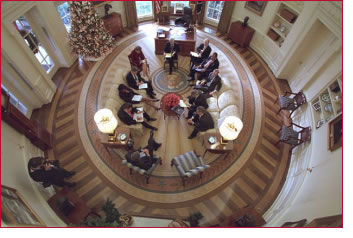
President George W. Bush meets with advisers in the Oval Office in 2009.
Council of Economic Advisors
The three members of the CEA, which must be confirmed by the Senate, each have a staff that includes advisors and assistants. The CEA also assists the President in preparing the annual Economic Report that is published and presented to Congress not long after the budget is submitted.
Visit the Council of Economic Advisors to learn more about the CEA.
Visit Council of Economic Advisors- Research to learn more about the Economic Report. Here you can click on the most recent Economic Report of the President or access previous reports.
Other Offices of the EOP
In addition to the White House Office, National Security Council, Office of Management and Budget, and Council of Economic Advisors, there are several other agencies within the EOP that assist the President:
- Council on Environmental Quality
- Office of Administration
- National Drug Control Policy
- Office of Science and Technology Policy
- Office of the United States Trade Representative
- Office of the Vice President
Visits the websites above to learn more about the EOP.
The President's Cabinet

Visit Ben's Guide to learn more about the President's Cabinet.
The President's Cabinet
Another vital part of a presidential administration is the formal collection of the President's closest advisors, or Cabinet. The Cabinet includes the Vice President and the heads, or "secretaries", of each of the fifteen executive departments. Each department has specific areas of responsibility to control.
The cabinet is not mentioned in the Constitution; however, Article II does state the President "may require the opinion of the principle officer in each of the executive departments." The Constitution does not specify how many executive departments can or should be created. President George Washington had four executive department heads in his Cabinet.
Vice President of the United States
The Vice President is the only elected position, besides the President, within a presidential administration. The Vice President serves as a member of the Cabinet in addition to three other duties specified in the Constitution:
- Becomes President if the President is unable to serve
- Presides as President of the Senate
- Opens and counts electoral votes in a Presidential election
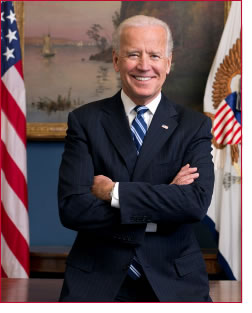
Joe Biden, the Vice President of the United States of America in 2014.
Vice President of the United States
The office of the Vice President is located close to the President's office, also known as the Oval Office, in the West Wing of the White House.
Visit Vice-President's Office to take a look at the office.
Visit Vice President to learn more.
Members of the Cabinet
In addition to the Vice President, the cabinet consists of 15 Cabinet secretaries, or heads of each department, that are chosen by the President and must be approved by a majority vote in the Senate. Hearings are held to determine whether appointees will be confirmed.
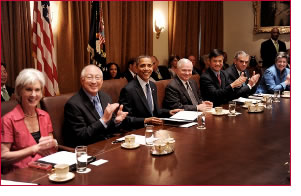
President Barak Obama and members of his cabinet.
Congress and Executive Departments
The Cabinet has grown over the years because the number of executive departments has increased. Executive departments are created by Congress and are subject to its oversight. Individual committees in Congress may subpoena Cabinet officials to aid in their investigations.
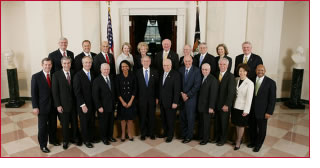
The Bush Cabinet, 2008.
.jpg)
The Clinton Cabinet, 1993.
Members of the Cabinet
Executive departments are also subject to some control by Congress. For example, Congress must approve appropriations or money to carry out programs developed by the departments.
Read The President's Cabinet to learn more.
Organization of Executive Departments
Executive departments are organized into a pyramidal structure with the Cabinet member as the top officer. Individual departments are often comprised of a vast array of organizations and agencies.

The organization chart for the Department of Education.
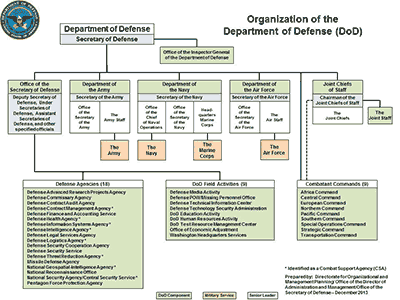
The organization chart for the Department of Defense.
Top Executive Departments
The first three executive departments created by Congress, the departments of State, Treasury, and Defense, are still among the most important today.
The Department of State advises the President on foreign policy matters. The head of the department, the Secretary of State, is the top-ranked member of the Cabinet and a member of the National Security Council.
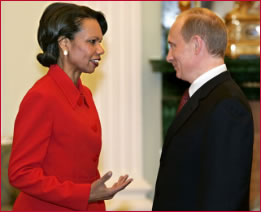
Former Secretary of State Condoleezza Rice speaks with Russian President Vladimir Putin in 2005.
Watch Condoleezza Rice to learn about her time growing up in Alabama.
Department of Treasury
The Department of Treasury recommends economic, tax, and fiscal policies; and it collects, spends, and manufactures the money required by the country. The Internal Revenue Service (IRS) is just one of the many divisions within the department. The Secretary of the Treasury is a major policy advisor to the President and manages the public debt.
Visit Treasury to learn more about the Department of Treasury.
Department of Treasury
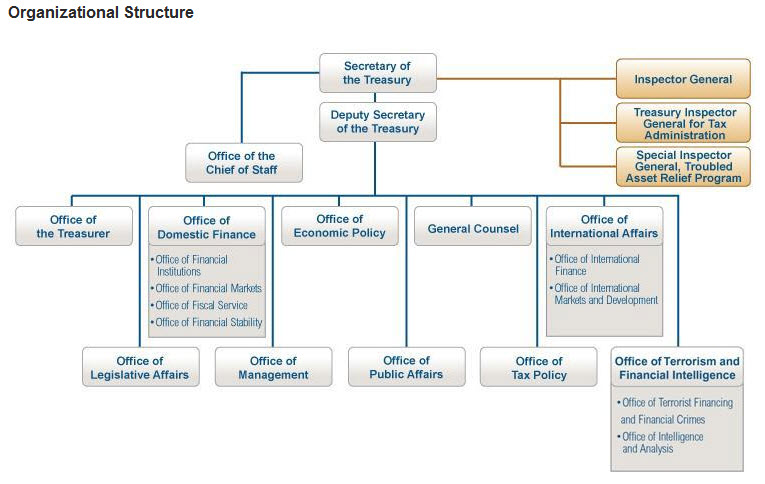
Department of Defense
The Department of Defense (DOD), originally the Department of War, is oversees the armed forces and provides the military forces necessary to prevent war and protect our country. The DOD is the largest executive department and carries out most of the President's duties as Commander in Chief.
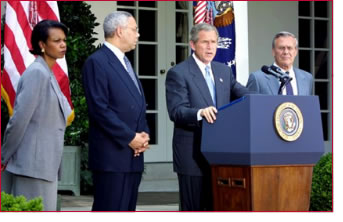
National Security Advisor Condoleeza Rice, Secretary of State Colin Powell, and Secretary of Defense Donald Rumsfeld listen to President George W. Bush speak about the Middle East in 2002.
Department of Defense
The Secretary of Defense and other secretaries (army, navy, and air force) must be civilians. However, the Joint Chiefs of Staff, which advise the Secretary of Defense and President, consist of the top-ranking military officers from each of the armed services.
Visit DOD to learn more about the Department of Defense.
Department of Justice
The Department of Justice is the fourth oldest executive department and the nation's largest law firm. It represents the citizens in enforcing the law.
The Federal Bureau of Investigation(FBI) is one of the most well-known divisions of the department.

The Robert F. Kennedy Department of Justice Building in Washington, D.C.
Department of Justice
The Secretaries of State, Treasury, and Defense along with the Attorney General made up the original Cabinet and are considered the most important members due to the importance of their departments. The Attorney General, head of the Department of Justice, is the only head of an executive department that is not referred to as Secretary.
Visit Justice 101 to learn more about the Department of Justice.
Other Executive Departments
In addition to the top four departments, there are eleven other executive departments whose heads are members of the President's Cabinet. Visit the websites below to learn about them.
- Department of the Interior (1849)
- Department of Agriculture (1862)
- Department of Commerce (1903)
- Department of Labor (1913)
- Department of Health and Human Services (1953)
- Department of Housing and Urban Development (1965)
- Department of Transportation (1966)
- Department of Energy (1977)
- Department of Education (1979)
- Department of Veterans Affairs (1988)
- Department of Homeland Security (2003)
Visit Ben's Guide for an overview of the Executive Departments.